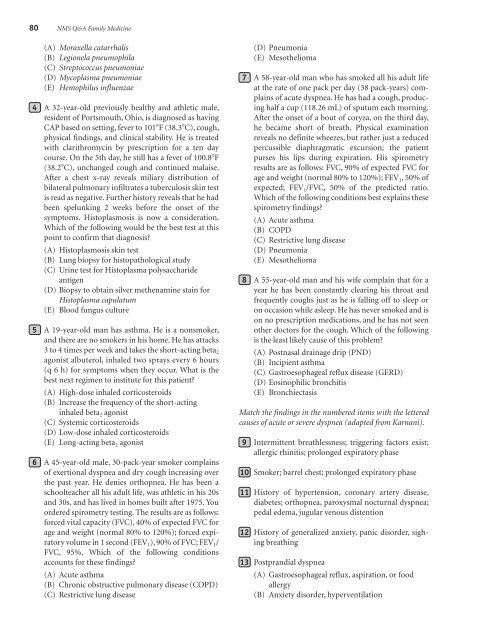NMS Q&A Family Medicine
NMS Q&A Family Medicine
NMS Q&A Family Medicine
- No tags were found...
You also want an ePaper? Increase the reach of your titles
YUMPU automatically turns print PDFs into web optimized ePapers that Google loves.
80 <strong>NMS</strong> Q&A <strong>Family</strong> <strong>Medicine</strong>(A) Moraxella catarrhalis(B) Legionela pneumophila(C) Streptococcus pneumoniae(D) Mycoplasma pneumoniae(E) Hemophilus influenzae4 A 32-year-old previously healthy and athletic male,resident of Portsmouth, Ohio, is diagnosed as havingCAP based on setting, fever to 101 F (38.3 C), cough,physical findings, and clinical stability. He is treatedwith clarithromycin by prescription for a ten daycourse. On the 5th day, he still has a fever of 100.8 F(38.2 C), unchanged cough and continued malaise.After a chest x-ray reveals miliary distribution ofbilateral pulmonary infiltrates a tuberculosis skin testis read as negative. Further history reveals that he hadbeen spelunking 2 weeks before the onset of thesymptoms. Histoplasmosis is now a consideration.Which of the following would be the best test at thispoint to confirm that diagnosis?(A) Histoplasmosis skin test(B) Lung biopsy for histopathological study(C) Urine test for Histoplasma polysaccharideantigen(D) Biopsy to obtain silver methenamine stain forHistoplasma capulatum(E) Blood fungus culture5 A 19-year-old man has asthma. He is a nonsmoker,and there are no smokers in his home. He has attacks3 to 4 times per week and takes the short-acting beta 2agonist albuterol, inhaled two sprays every 6 hours(q 6 h) for symptoms when they occur. What is thebest next regimen to institute for this patient?(A) High-dose inhaled corticosteroids(B) Increase the frequency of the short-actinginhaled beta 2 agonist(C) Systemic corticosteroids(D) Low-dose inhaled corticosteroids(E) Long-acting beta 2 agonist6 A 45-year-old male, 30-pack-year smoker complainsof exertional dyspnea and dry cough increasing overthe past year. He denies orthopnea. He has been aschoolteacher all his adult life, was athletic in his 20sand 30s, and has lived in homes built after 1975. Youordered spirometry testing. The results are as follows:forced vital capacity (FVC), 40% of expected FVC forage and weight (normal 80% to 120%); forced expiratoryvolume in 1 second (FEV 1 ), 90% of FVC; FEV 1 /FVC, 95%. Which of the following conditionsaccounts for these findings?(A) Acute asthma(B) Chronic obstructive pulmonary disease (COPD)(C) Restrictive lung disease(D) Pneumonia(E) Mesothelioma7 A 58-year-old man who has smoked all his adult lifeat the rate of one pack per day (38 pack-years) complainsof acute dyspnea. He has had a cough, producinghalf a cup (118.26 mL) of sputum each morning.After the onset of a bout of coryza, on the third day,he became short of breath. Physical examinationreveals no definite wheezes, but rather just a reducedpercussible diaphragmatic excursion; the patientpurses his lips during expiration. His spirometryresults are as follows: FVC, 90% of expected FVC forage and weight (normal 80% to 120%); FEV 1 , 50% ofexpected; FEV 1 /FVC, 50% of the predicted ratio.Which of the following conditions best explains thesespirometry findings?(A) Acute asthma(B) COPD(C) Restrictive lung disease(D) Pneumonia(E) Mesothelioma8 A 55-year-old man and his wife complain that for ayear he has been constantly clearing his throat andfrequently coughs just as he is falling off to sleep oron occasion while asleep. He has never smoked and ison no prescription medications, and he has not seenother doctors for the cough. Which of the followingis the least likely cause of this problem?(A) Postnasal drainage drip (PND)(B) Incipient asthma(C) Gastroesophageal reflux disease (GERD)(D) Eosinophilic bronchitis(E) BronchiectasisMatch the findings in the numbered items with the letteredcauses of acute or severe dyspnea (adapted from Karnani).9 Intermittent breathlessness; triggering factors exist;allergic rhinitis; prolonged expiratory phase10 Smoker; barrel chest; prolonged expiratory phase11 History of hypertension, coronary artery disease,diabetes; orthopnea, paroxysmal nocturnal dyspnea;pedal edema, jugular venous distention12 History of generalized anxiety, panic disorder, sighingbreathing13 Postprandial dyspnea(A) Gastroesophageal reflux, aspiration, or foodallergy(B) Anxiety disorder, hyperventilation
















